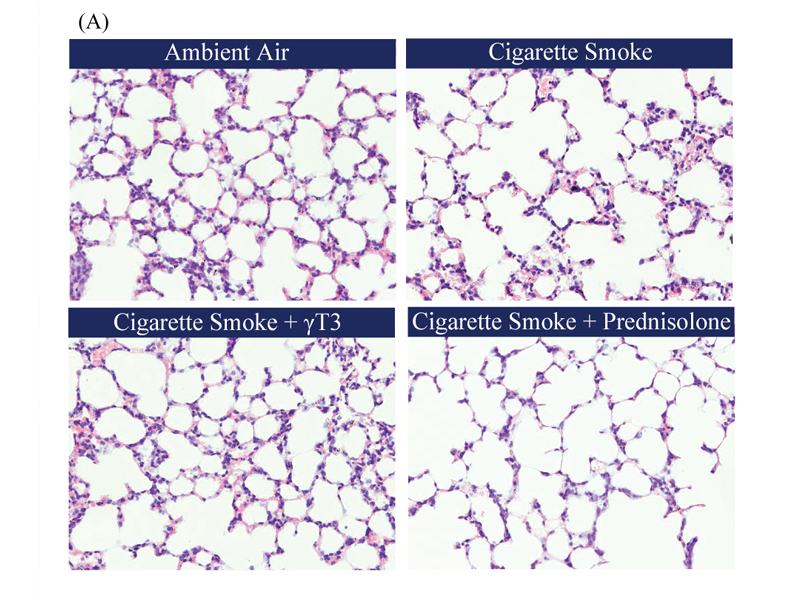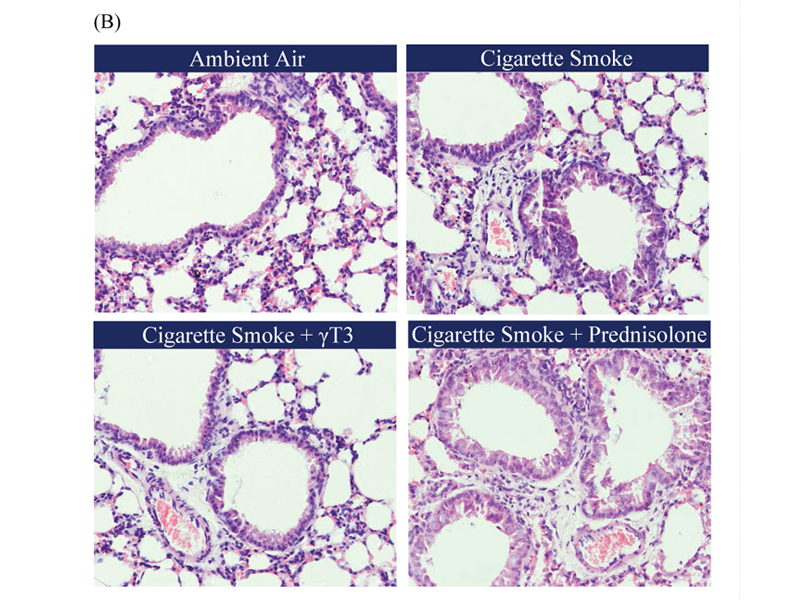Vitamin E Isoform γ-Tocotrienol May Help Protect Against Emphysema in COPD
By Dr Peh Hong Yong &
Associate Professor W.S. Fred Wong
Department of Pharmocology
Vitamin E can be found in vegetables, fruits and plant oils, and is widely recognised for its antioxidant property. There are a total of 8 isoforms of vitamin E, namely α-, β-, γ- and δ-tocopherol, and α-, β-, γ- and δ-tocotrienol. In its pure form, vitamin E is a yellowish viscous oil that oxidises readily when exposed to light and oxygen. All along, γ-tocopherol is perceived to be the active antioxidant isoform for vitamin E. However, we have found that the γ-tocotrienol form of vitamin E is more effective than γ-tocopherol in neutralising free radicals in the lungs.
Chronic obstructive pulmonary disease (COPD) is characterised by airway inflammation, airway remodeling and emphysema, leading to chronic cough, breathlessness and impaired lung function in patients. The prevalence of COPD is increasing, with a global burden of over 600 million patients worldwide, with approximately three million deaths annually. It is currently the fourth leading cause of death worldwide, with cigarette smoke as the leading risk factor for COPD. Cigarette smoke contains massive amounts of oxidants on its own (~1015 radicals per puff), resulting in oxidative stress and inflammation in the lungs. We hypothesised that the γ-tocotrienol form of vitamin E can mitigate inflammation and oxidative stress in COPD.
Indeed, in a cigarette smoke-induced experimental COPD animal model, γ-tocotrienol was found to be more effective than corticosteroid drug (prednisolone) in reducing neutrophil counts and pro-inflammatory mediators like IL-6, IL-17, G-CSF, and GM-CSF in the lung lavage fluid. MUC5B is the main mucin glycoprotein responsible for mucus production in COPD, and γ-tocotrienol attenuated MUC5B gene expression in the lungs. In addition, γ-tocotrienol was better than corticosteroid drug in relieving oxidative DNA, protein and lipid damage in the airways, by effectively neutralising free radicals and restoring endogenous antioxidant capacities. Moreover, γ-tocotrienol protected against emphysematous destruction of alveolar sacs, and improved lung functions (e.g. total lung capacity and FEV100/FVC) in the COPD model. We reported our findings on June 30 this year in Free Radical Biology and Medicine, a top cited journal in its field.
These findings provide new insights into the beneficial effects of γ-tocotrienol form of vitamin E in mitigating lung inflammation and oxidative damage, prevention of emphysema development, and improving lung function in COPD. The next step of our research is to verify these protective benefits of γ-tocotrienol in COPD patients. If proven effective clinically, γ-tocotrienol may potentially delay disease progression, improve patients’ quality of life, and reduce COPD deaths.


1. Peh HY, Tan WSD, Chan TK, Pow CW, Foster PS, et al. (2017) Vitamin E isoform γ-tocotrienol protects against emphysema in cigarette smoke-induced COPD. Free Radical Biology and Medicine. 110:332-344.
2. Peh HY, Tan WSD, Liao WP and Wong WSF. (2016) Vitamin E therapy beyond cancer: tocopherol versus tocotrienol. Pharmacology and Therapeutics. 162:152-169.
3. Peh HY, Ho WE, Chan TK, Seow ACG, Cheng C, et al. (2015) Vitamin E isoform γ-Tocotrienol down regulates house dust mite-induced asthma. Journal of Immunology. 195: 437-444.
4. Sin DD and Vestbo J. (2009) Biomarkers in Chronic Obstructive Pulmonary Disease. Proceedings of the American Thoracic Society. 6:543-545.
5. Pryor WA and Stone K. (1993) Oxidants in Cigarette Smoke Radicals, Hydrogen Peroxide, Peroxynitrate, and Peroxynitritea. Annals of the New York Academy of Sciences. 686:12-27.
6. Barnes PJ. (2013) Corticosteroid resistance in patients with asthma and chronic obstructive pulmonary disease. Journal of Allergy and Clinical Immunology. 131:636-645.
